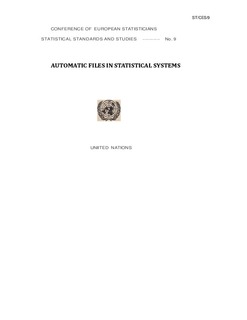| dc.contributor.author | Nordbotten, Svein | |
| dc.date.accessioned | 2012-02-25T14:46:04Z | |
| dc.date.available | 2012-02-25T14:46:04Z | |
| dc.date.issued | 1967 | |
| dc.identifier.citation | Nordbotten, S.(1967b): Automatic Files in Statistical Systems. Statistical Standards and Studies. Handbook No. 9. United Nations. N.Y. | no_NO |
| dc.identifier.uri | http://hdl.handle.net/11250/178267 | |
| dc.description.abstract | The existing statistical systems are designed for satisfying conditions which are changing rapidly today. The most marked feature of the existing systems of many countries is their extensive periodic surveys.
The surveys aim at presentation of statistics which are internally consistent and compatible with results for different periods or points of time. The individual observations of any two surveys are, however, usually incompatible because the individuals are not permanently identified. This individual incompatibility implies that any survey must be self-supplying with respect to all data required for the compatibility of aggregates. The system requires that respondents have to answer certain questions about facts reported one or perhaps many times previously because these are needed for classification purposes in order to obtain results compatible with those from preceding or parallel surveys.
The data collected for a survey have usually been utilized in one computation process and have been considered as useless for any later utilization because of the large cost of making them ready for a new process. This has led to extensive processing schemes for each survey aiming at a large volume of general purpose results for present and anticipated needs. This means totals or averages for a large number of classes in the population investigated. The extensive schemes of processing have also been very time-consuming with statistical results which, for example, were available 2-4 years after a decennial census was taken. The average age for statistics from such censuses would therefore be 7-9 years.
What are the future needs for statistical information from national statistical systems in societies which are growing more and more complex? A probable answer to the question may perhaps be: special 'statistical services and fast statistical measurement of changes in addition to the general purpose statistics. | no_NO |
| dc.language.iso | eng | no_NO |
| dc.publisher | United Nations Statistical Commission and Economic Commission for Europe. Conference of European Statisticians | no_NO |
| dc.relation.ispartofseries | Statistical Standards and Studies. Handbook;No. 9 | |
| dc.relation.uri | http://www.nordbotten.com/frame.htm | |
| dc.subject | Data processing | no_NO |
| dc.subject | Statistical production | no_NO |
| dc.subject | Data file system | no_NO |
| dc.subject | Svein Nordbotten | |
| dc.title | Automatic files in statistical systems | no_NO |
| dc.type | Conference lecture | en |
| dc.subject.nsi | VDP::Mathematics and natural science: 400::Information and communication science: 420 | no_NO |
| dc.subject.nsi | VDP::Mathematics and natural science: 400::Mathematics: 410::Statistics: 412 | no_NO |
| dc.source.pagenumber | 49 s. | no_NO |
